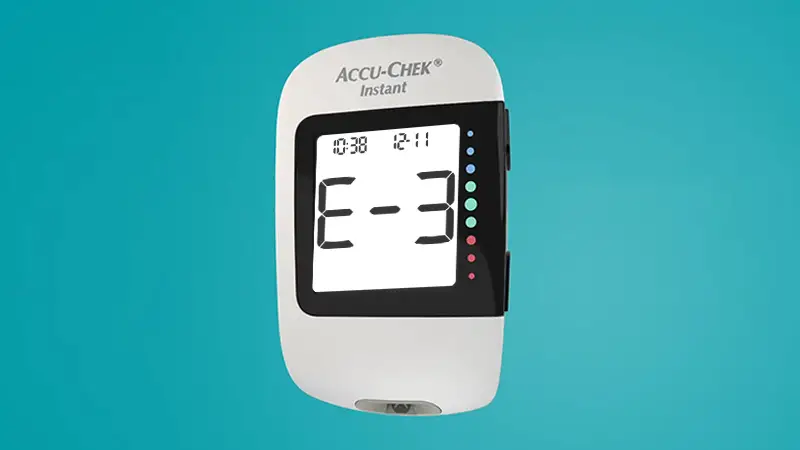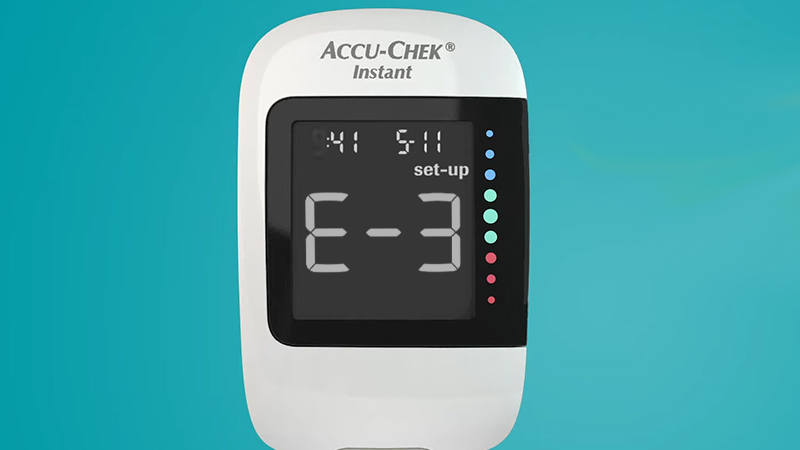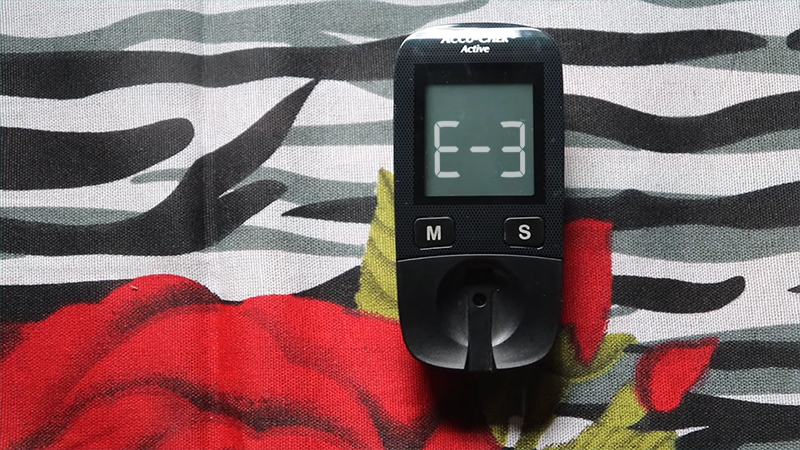The ACCU-CHEK E3 error, a common occurrence for users of ACCU-CHEK blood glucose meters, is a perplexing issue that can disrupt effective blood glucose monitoring.
This error message appears when the meter encounters difficulties in reading the test strips or blood samples, rendering it unable to provide accurate glucose measurements.
To address this problem, it’s essential to understand both the causes and fixes associated with the ACCU-CHEK E3 error.
Causes of the ACCU-CHEK E3 error range from expired test strips and incorrect coding to inadequate blood samples and meter malfunctions. Issues like dirty or damaged strips, low battery, exposure to extreme temperatures, and meter contamination can also trigger this error.
In the subsequent sections, we will delve into accu chek e3 error – causes and fixes to help users effectively manage and prevent the ACCU-CHEK E3 error, ensuring that blood glucose monitoring remains reliable and accurate.
What Is Accu Chek E3 Error?

The ACCU-CHEK E3 error is a specific error message that can be displayed on certain ACCU-CHEK blood glucose meters. This error typically indicates an issue with the meter or the test strips being used.
It can have various causes, such as a malfunction in the meter itself, improper handling of the test strips, expired or damaged test strips, or inadequate blood sample application.
When the ACCU-CHEK E3 error appears, it means that the meter couldn’t properly read the test strip or the blood sample, and as a result, it cannot provide an accurate blood glucose measurement.
To resolve this error, it’s important to check the test strip, ensure that it’s properly inserted into the meter, and that the blood sample is correctly applied.
If the error persists, you may need to contact the manufacturer’s customer support or refer to the user manual for specific troubleshooting steps.
Always consult your healthcare provider for further guidance on managing your blood glucose levels.
Accu Chek E3 Error – Causes

Here’s Accu chek e3 error – causes:
Expired Test Strips
One of the common causes of the ACCU-CHEK E3 error is using expired test strips. Test strips have a limited shelf life, and using them after their expiration date can lead to inaccurate readings and errors.
Incorrect Test Strip Coding
ACCU-CHEK meters require proper coding to match the code on the test strip vial. If the coding on the meter doesn’t match the coding on the strips, the E3 error can occur. Ensure that the code numbers on both the meter and the test strip vial match.
Inadequate Blood Sample
Insufficient blood on the test strip can result in an E3 error. It’s crucial to provide an adequate blood sample to the test strip according to the manufacturer’s instructions.
Dirty or Contaminated Test Strips
Test strips can be affected by dirt, moisture, or contaminants. If the strips are not clean or have been contaminated, the meter might not be able to read them properly, leading to the E3 error.
Meter Malfunction
Sometimes, the E3 error can occur due to a malfunction in the meter itself. This can be a technical issue within the device that hinders its ability to read the test strips accurately.
Incorrect Handling of Test Strips
Incorrect handling, such as bending or damaging the test strips, can lead to errors. Properly storing and handling the strips according to the manufacturer’s guidelines is essential to avoid the E3 error.
Low Battery
If the meter’s battery is low, it might not function properly, leading to errors including E3. Make sure the meter has sufficient power to operate effectively.
Extreme Temperatures
Exposure to extreme temperatures, either too hot or too cold, can damage both the meter and the test strips. This damage can prevent accurate readings, resulting in errors like E3.
Meter Contamination
If the meter’s test strip insertion point is dirty or contaminated, it can interfere with the proper insertion and reading of the test strip, causing the E3 error. Regularly clean the insertion point following the manufacturer’s instructions to prevent contamination-related errors.
Accu Chek E3 Error – Fixes

Here are some possible fixes for the ACCU-CHEK E3 error:
Check Test Strip Expiration Date
Ensure that the test strips you are using have not expired. Expired strips can lead to the E3 error. If they are past their expiration date, discard them and use a fresh, unexpired batch.
Properly Code the Meter
Verify that the code on the meter matches the code on the test strip vial. If they don’t match, adjust the meter’s code to match the code on the vial. Proper coding is crucial to avoid the E3 error.
Apply Adequate Blood Sample
To prevent the E3 error due to inadequate blood samples, make sure you have enough blood to fill the test strip properly. Follow the manufacturer’s instructions for applying the right amount of blood.
Inspect Test Strips for Contaminants
Check the test strips for any visible contaminants or damage. If they appear dirty or compromised in any way, use a clean, undamaged strip from a fresh container.
Replace the Meter Batteries
If your meter is displaying an E3 error and the batteries are low, replace them with fresh ones. Low batteries can affect the meter’s performance, and a new set may resolve the issue.
Properly Store and Handle Test Strips
Ensure you store the test strips in a cool, dry place, following the manufacturer’s storage guidelines. Avoid bending or damaging the strips during storage or handling to prevent the E3 error.
Contact Customer Support
If you suspect a malfunction in the meter itself or if none of the above steps resolve the E3 error, contact the manufacturer’s customer support for guidance or a possible replacement of the meter.
Protect from Extreme Temperatures
Keep both the meter and the test strips within the recommended temperature range. Extreme heat or cold can damage them, so avoid exposing them to such conditions.
Clean the Meter’s Insertion Point
Regularly clean the test strip insertion point on the meter with a lint-free cloth or an alcohol swab, as recommended by the manufacturer. A clean insertion point can prevent the E3 error due to contamination and ensure accurate readings.
FAQs
What is the ACCU-CHEK E3 error, and why does it occur?
The ACCU-CHEK E3 error is an error message that appears on certain ACCU-CHEK blood glucose meters. It occurs when the meter encounters issues with reading the test strips or blood samples.
How can I prevent the ACCU-CHEK E3 error due to test strip issues?
To prevent the E3 error related to test strips, always check the expiration date, properly code the meter, ensure an adequate blood sample is applied, and inspect the strips for contaminants or damage.
What should I do if my ACCU-CHEK meter displays an E3 error due to battery issues?
If your meter shows an E3 error due to a low battery, replace the batteries with fresh ones. Keeping the meter powered up is essential to avoid this issue.
How do I address the ACCU-CHEK E3 error caused by extreme temperatures?
Protect your meter and test strips from extreme temperatures. Store them within the recommended temperature range, preventing both hot and cold exposure to avoid potential damage and the E3 error.
What can I do if none of the troubleshooting steps resolve the ACCU-CHEK E3 error?
If you’ve attempted all the recommended fixes and the E3 error persists, consider reaching out to the manufacturer’s customer support. They can provide further guidance and, if necessary, assist with a replacement meter to ensure accurate blood glucose monitoring.
Conclusion
The ACCU-CHEK E3 error, though frustrating, can be successfully managed with the right knowledge and corrective actions.
Understanding the array of potential causes—including issues with test strips, coding, blood samples, meter functionality, and external factors like temperature—enables users to identify the root of the problem.
Equally crucial are the fixes, which range from simple steps like checking expiration dates and applying adequate blood samples to proper coding, regular maintenance, and reaching out to customer support when necessary.
By implementing these fixes, users can minimize the occurrence of the ACCU-CHEK E3 error and ensure that their blood glucose monitoring remains accurate and reliable.
This knowledge empowers individuals managing their health to navigate this common challenge with confidence, ultimately improving their overall well-being.
Hi, I’m Mark Pattinson and I’m a freelance personal trainer. I’ve been working in the fitness industry for over 10 years especially since I work with diabetes patients and I love helping people achieve their fitness goals. I believe that everyone can benefit from a good workout, and I’ll do everything to make sure you get the most out of your training.